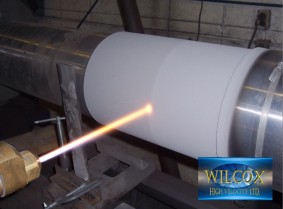Looking for HVOF Coatings in Alberta?
 HVOF stands for High Velocity Oxygen Fuel. These HVOF coatings use a thermal spray system that utilizes the combustion of gasses. Oxygen and fuel mix and atomize within the combustion area under conditions that monitor the correct combustion mode and pressure. The HVOF thermal spray coating may use a range of coating materials such as metals, alloys, plastics, composites, and ceramics. HVOF coatings are used to produce high-quality and resistant satellites and carbides. Specifically, the purpose of the coating is to extend the life of the sprayed equipment by significantly reducing wear, corrosion, and erosion.
HVOF stands for High Velocity Oxygen Fuel. These HVOF coatings use a thermal spray system that utilizes the combustion of gasses. Oxygen and fuel mix and atomize within the combustion area under conditions that monitor the correct combustion mode and pressure. The HVOF thermal spray coating may use a range of coating materials such as metals, alloys, plastics, composites, and ceramics. HVOF coatings are used to produce high-quality and resistant satellites and carbides. Specifically, the purpose of the coating is to extend the life of the sprayed equipment by significantly reducing wear, corrosion, and erosion.
HVOF Coating Process
As the name suggests, HVOF coatings use a high-velocity (near supersonic), low-temperate spraying process. A Lower temperature is permissible because fusion is achieved with the kinetic energy, rather than the temperature, of the particles. The HVOF coating material is heated and propelled by the gas stream towards the surface of the item being sprayed. The thermal spray coating consists of overlapping platelets. These coatings are strongly bonded and low in porosity. These characteristics allow for quick thick applications. The result of the high gas and particle velocity process is an exceptional coating quality.
Types of HVOF Coatings
HVOF equipment uses oxygen and a fuel mix to heat and propel the coating material to the equipment surface. The different types of HVOF coatings are based on the fuel used and the oxygen source. The types of fuels available are hydrogen, natural gas, or kerosene. The oxygen source can be either pure oxygen or compressed air. As mentioned above, depending on the specific needs, several coating materials may be used. These include MCrAIY materials. M = iron, nickel, cobalt. Cr is chromium, Al is aluminum and Y is yttrium.
HVOF Benefits
The benefits of HVOF coatings include:
- Reduced costs, as components last longer and need less maintenance.
- Improved performance and wear resistance due to harder coatings.
- Greater temperature range functionality due to versatile coating.
- Greater harsh chemical resistance due to higher density coating.
- Lower porosity due to high impact velocity.
- Ease of coating larger components.
- Relatively low-temperature coating.
- Lower oxide use due to the speed of the particles. The speed results in less particle heat exposure. The lower temperatures compared to alternative processes also lower the oxides.
- Smoother finishes due to higher velocity impacts and smaller powder sizes.
To learn more about our High-Performance Coatings and the types we offer, click here. If you have any questions about HVOF or are interested in our services contact us by emailing [email protected] or calling 780-483-8861.